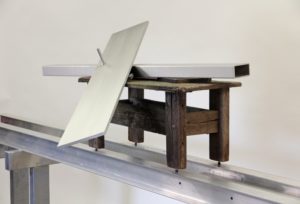Local artist Daniel Laskarin has created thought-provoking works of art for decades. His new exhibition, ruins and reclamation, seeks to display the order within the disorder. Combining history, used materials, and visual metaphor, Laskarin has once again created work that is both visually and intellectually engaging.
“Language-based thought is pretty good, but it isn’t the whole story,” says Laskarin, who is also associate professor and chair of the department of Visual Arts at the University of Victoria. “The kind of visual thought, tactile thought, and physical thought that can be manifested in visual art is also an important way of knowing the world.”
Laskarin’s unique approach to artwork comes from his background in the aircraft industry as a helicopter pilot and engineer.
“When I was flying, we weren’t using GPS,” he says. “You’d be flying and you’d have your finger on a very large-scale map showing all the line contours and major geographical features.”

Laskarin explored how the maps he used were made, and that got him started on the work he now loves.
“I started approximating the way maps are made using photography,” he says. “I would take 300, 350 photographs of a single subject and composite them together to make an overall image.”
The other aspect of Laskarin’s former profession that informed his current one was the fact that he worked on the physical structure of the helicopters he piloted.
“I also worked as an aircraft maintenance engineer,” he says, “and that furthered my interest in the making of stuff and the materiality of stuff, just working with tools and materials.”
Laskarin keeps his pilot and maintenance hands at work in the studio, doing everything from sculpting to robotics.
“My work is in one way or another really connected to the physicality of our being,” he says. “In a way, art-making might be more like a form of athleticism than a form of language-based philosophy. Good athletes are thinking through their bodies, and it’s a very particular way of viewing the world.”
Alongside Laskarin’s emphasis on the physical side of art-making is the philosophy of existence and personal creation. He says that a lot of the works he makes are, in a way, “other selves.”
“I tend to work on things that are about the size of a person,” he says. “The pieces come together, the way a self comes together the way a personality and an individual comes together; the piece has its own identity that’s not like other things.”
ruins and reclamation seeks to capture the makeshift, unstructured nature in which our lives are assembled. The exhibit piece “how a thing is made,” for example, was inspired by an old pile of wood.
“Some pieces of lumber fell in a very awkward and precarious way on an old work table,” Laskarin says, “and I was just curious by it. I was fascinated at the precariousness of it.”
Laskarin says that coming up with ideas is easy, but acting on it is what matters.
“Ideas are coming from all over the place. Sometimes they come from an ethereal source. Sometimes from a philosophical one,” he says. “Ideas are crap. Ideas are a dime a dozen. What matters is what you do with the idea. If you wait for a good idea before you start to make art, you’ll never make anything, so you have to just take a crappy idea and try to make something good out of it.”
Making art and sharing it with the world is never easy. Laskarin says opposition is ongoing for an artist.
“I think success as an artist is just managing to keep making it,” he says. “You constantly go into and go out of periods of wondering why you’re doing this, but I keep coming back to it because it’s the only way I can think about things.”
ruins and reclamation
Until Saturday, October 7
Deluge Contemporary Art
deluge.ca
